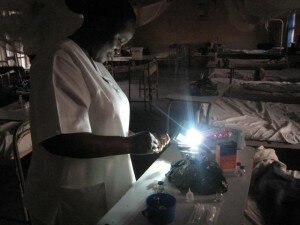Imagine a hospital without light
A Story from Rural Nigerian Maternity Wards by Laura Stachel of WE CARE Solar

A Nigerian nurse prepares injections by the light of her solar lamp.
I have travelled to Northern Nigeria several times over the last two years to learn about emergency care of childbearing women and their children. 60% of Nigeria has no access to electricity, and the remaining 40% that do have access, only have electricity for a few hours a day. Sadly, even hospitals are included in this rationing of power. Time and time again, I witnessed situations where effective light could be the difference between performing a procedure or sending a patient away, between doing a c/section or transferring a woman to another hospital, between life and death.
In response to the deficiencies in light and electricity at the hospital, I co-founded an organization called WE CARE Solar – Women’s Emergency Communication And Reliable Electricity. Our first project was to provide solar powered overhead lighting to some wards of one state hospital – specifically the maternity ward, labor/delivery room, and operating room. These facility improvements have made a huge difference for health care workers and patients in these wards. But… as so many hospital staff have reminded me, the solar-powered wards are “islands of light in a sea of darkness.”
Laura Stachel visiting clinics in Northern, Nigeria
We’ve since partnered with One Million Lights to equip the hospital staff with personal solar lights to grow these islands of light. One of the highlights of my last trip to Nigeria was field testing One Million Lights’ solar lights with the hospital staff in a Northern Nigerian hospital. These lights are the brightly colored flashlights (called “torch lights” in Nigeria) that come with rechargeable batteries….charged by the sun! They have a great light, are easy to use, and have a clasp on the end that allows them to be suspended from a hook.
The midwives and nurses loved the lights and demonstrated how useful they could be in the hospital. The pediatric ward, for example, was so dark at 6 pm, that it was impossible to administer intravenous (IV) medications, or start an IV line on the critically ill children that lined the ward. The pediatric nurse hooked the solar light onto the mosquito net in the ward and the light enabled her to see the medications to quickly provide the care that was needed for each child.
Dignitiaries celebrate the arrival of the solar lights
News immediately traveled through the hospital, and soon I was besieged by requests for lights from One Million lights. Pharmacists, laboratory techs, medical ward nurses, and emergency triage staff all saw the utility of these lights. I will be returning to the hospital this month, armed with 50 more lights from One Million Lights, knowing I’ll be providing a little bit of “light” for the dedicated hospital staff with whom I work.
Some of the pink solar lights you see in the pictures were donated by Karen Landry in honor of her dear friend, Nancy Alden.
Help Laura take more lights to Nigeria on her next trip by donating a light for maternal health here.

